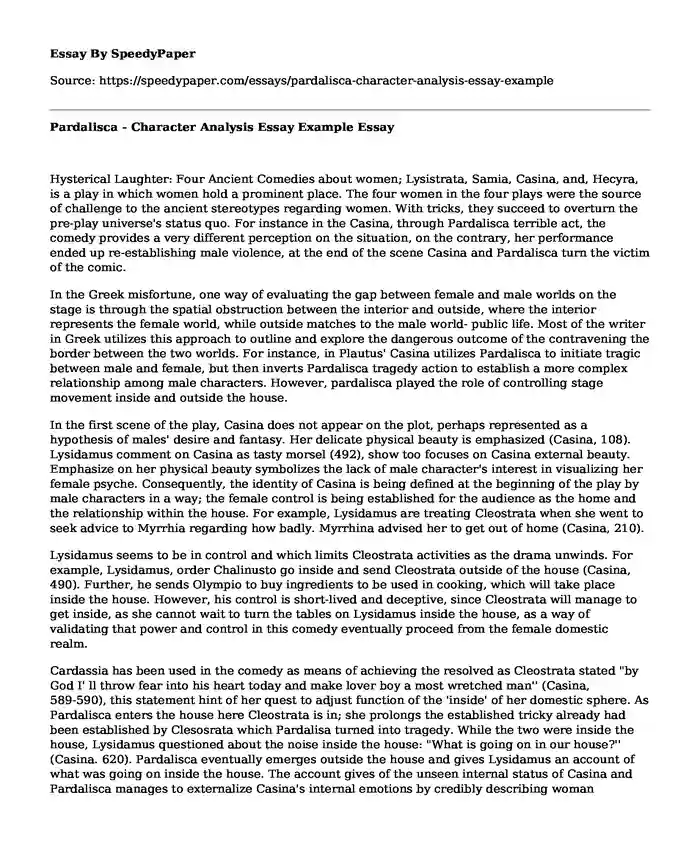
| Type of paper: | Essay |
| Categories: | Women Stereotypes Character analysis |
| Pages: | 3 |
| Wordcount: | 820 words |
Hysterical Laughter: Four Ancient Comedies about women; Lysistrata, Samia, Casina, and, Hecyra, is a play in which women hold a prominent place. The four women in the four plays were the source of challenge to the ancient stereotypes regarding women. With tricks, they succeed to overturn the pre-play universe's status quo. For instance in the Casina, through Pardalisca terrible act, the comedy provides a very different perception on the situation, on the contrary, her performance ended up re-establishing male violence, at the end of the scene Casina and Pardalisca turn the victim of the comic.
In the Greek misfortune, one way of evaluating the gap between female and male worlds on the stage is through the spatial obstruction between the interior and outside, where the interior represents the female world, while outside matches to the male world- public life. Most of the writer in Greek utilizes this approach to outline and explore the dangerous outcome of the contravening the border between the two worlds. For instance, in Plautus' Casina utilizes Pardalisca to initiate tragic between male and female, but then inverts Pardalisca tragedy action to establish a more complex relationship among male characters. However, pardalisca played the role of controlling stage movement inside and outside the house.
In the first scene of the play, Casina does not appear on the plot, perhaps represented as a hypothesis of males' desire and fantasy. Her delicate physical beauty is emphasized (Casina, 108). Lysidamus comment on Casina as tasty morsel (492), show too focuses on Casina external beauty. Emphasize on her physical beauty symbolizes the lack of male character's interest in visualizing her female psyche. Consequently, the identity of Casina is being defined at the beginning of the play by male characters in a way; the female control is being established for the audience as the home and the relationship within the house. For example, Lysidamus are treating Cleostrata when she went to seek advice to Myrrhia regarding how badly. Myrrhina advised her to get out of home (Casina, 210).
Lysidamus seems to be in control and which limits Cleostrata activities as the drama unwinds. For example, Lysidamus, order Chalinusto go inside and send Cleostrata outside of the house (Casina, 490). Further, he sends Olympio to buy ingredients to be used in cooking, which will take place inside the house. However, his control is short-lived and deceptive, since Cleostrata will manage to get inside, as she cannot wait to turn the tables on Lysidamus inside the house, as a way of validating that power and control in this comedy eventually proceed from the female domestic realm.
Cardassia has been used in the comedy as means of achieving the resolved as Cleostrata stated "by God I' ll throw fear into his heart today and make lover boy a most wretched man'' (Casina, 589-590), this statement hint of her quest to adjust function of the 'inside' of her domestic sphere. As Pardalisca enters the house here Cleostrata is in; she prolongs the established tricky already had been established by Clesosrata which Pardalisa turned into tragedy. While the two were inside the house, Lysidamus questioned about the noise inside the house: "What is going on in our house?'' (Casina. 620). Pardalisca eventually emerges outside the house and gives Lysidamus an account of what was going on inside the house. The account gives of the unseen internal status of Casina and Pardalisca manages to externalize Casina's internal emotions by credibly describing woman experiencing the excitement as she introduces her entrance onto the scene. Pardalisca's arrival in the scene gives her chance to move freely inside and outside the house to externalize the feelings of Casina. Pardalisca's terrible performance unveils what Cleostrata's warning meant: as soon as Cleostrata undertakes inventive control of the dramatic performance, the shift from male to female artistic govern immediately escorted by a corresponding shift in genre from comedy to tragedy. The character Pardalisca comes in, gives misleading statements that Casina has gone mad inside the house, and impended to kill any male who will try to sleep with her that night (Casina. 621). Pardalisca performance that combines the seen and unseen events creates fear and desire in Lysidamus. Further, she alleges to Lysidamus that Casina's violent, mad behavior and emotions are due to Lysidamus's persistence on Casina's marrying Oloympio (Casina, 678). Lysidamus finally humbles before Pardalisca to seek for his permission to Cleostrata to enter Casina. Because of her performance, Pardalisca comes into a realization of his ignorance and change his viewpoint, suggesting women victory regarding power and control.
Pardalisca's tragic scene emphasized the emotional and physical control of women and their fruitful challenge to breach those restraints; therefore, enabling reshaping Casina indirectly to support the adopting and repression of male violence and which turned male violence back against the male characters, preferably of against female characters. Eventually, the male characters not only became their dupes but also as the comic victims of the female characters in the play.
Cite this page
Pardalisca - Character Analysis Essay Example. (2022, Sep 05). Retrieved from https://speedypaper.com/essays/pardalisca-character-analysis-essay-example
Request Removal
If you are the original author of this essay and no longer wish to have it published on the SpeedyPaper website, please click below to request its removal:
- Essay Sample about the Difference Between the Islamic Conventional Banking Systems
- Free Essay on Marijuana Policy Project
- Free Essay with a Research on Body Image of College Students
- Free Essay about U.S Democratic System
- Literary Essay Sample: Vernacular Forms and Influence on Margaret Walker's Works
- Religion Essay Sample: The Similarities and Differences between the Sunni and Shiite Muslims
- Essay Example on Life Is Made Up of Decisions
Popular categories




